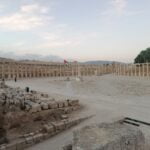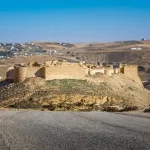Qasr Al-Mshatta A Timeless Wonder in Jordan
Qasr Al-Mshatta, also known as Al-Mshatta Castle, is a beautiful and unique archaeological site located in the heart of Jordan. About 30 kilometers south of Amman, the capital of Jordan, this large and impressive building holds an important place in Jordanian history and showcases the rich cultural heritage of the region.
Dating back to the 8th century during the Umayyad Caliphate, Qasr Al-Mshatta reflects the architectural brilliance of that era. Construction began in 743 AD under the orders of Caliph Al-Walid II, but it was left unfinished after his sudden death in 744 AD. Despite its incomplete state, the palace remains a testament to the greatness and beauty of the Umayyad dynasty, which played a key role in shaping Arab-Islamic civilization.
One of the most remarkable features of Qasr Al-Mshatta is its exceptional architecture. The palace combines influences from Roman, Byzantine, and Arab styles, representing the diverse cultural integration of the time. Its large rectangular structure features a richly decorated facade, with intricate carvings, elegant patterns, and beautifully crafted friezes adorning the exterior walls. These details highlight the incredible skill of the Umayyad craftsmen.
Throughout history, Qasr Al-Mshatta has faced many challenges, including neglect, damage, and the effects of weather. Despite these difficulties, efforts have been made to preserve and protect this architectural gem. In the late 19th century, Theodor Wiegand, a German engineer, carried out detailed excavations and documentation of the site. Today, many of the original carvings from Qasr Al-Mshatta are displayed in the Pergamon Museum in Berlin, Germany, giving people worldwide a chance to appreciate its cultural significance.
In modern times, Qasr Al-Mshatta remains a must-visit historical site and a popular tourist attraction. Visitors can explore the ruins, marvel at the architectural details, and admire the craftsmanship that has survived centuries. Though unfinished, the palace’s grandeur and the stories it tells offer a mesmerizing experience for history enthusiasts, architects, and cultural travelers alike.








